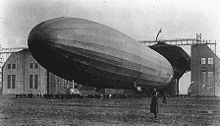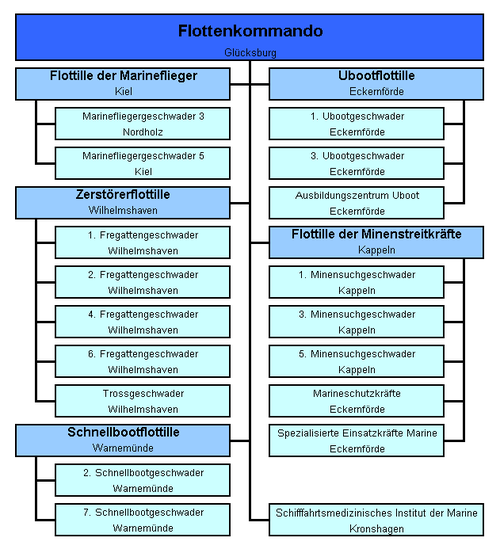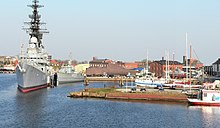German naval history

The German naval history includes the navies and fleets of German states, both individual states such as Prussia , and federal states such as the Federal Republic of Germany . Part of this story are the plans and further attempts to build armed forces at sea.
Today's German Navy regards June 14, 1848 as its founding day , when the Frankfurt National Assembly decided to set up the Imperial Fleet. The history of today's German state and its naval organization began with the founding of the North German Confederation in 1867. After the Second World War , Germany was without a navy for a few years.
The task of a German navy is normally the defense of the German coasts and possibly of waters that are relevant to German security and economy. In its naval history, Germany has made only a few attempts to act as a sea power with further ambitions. The best-known project was the establishment of the deep-sea fleet under Kaiser Wilhelm II before the First World War , while the similarly ambitious Z-Plan of the Kriegsmarine was only implemented to a limited extent due to the outbreak of the Second World War and is therefore less well known.
Holy Roman Empire

The empire has had to defend itself against threats to its coasts since Charlemagne . Warships were repeatedly equipped to ward off Frisians , Normans and Moors . In the 11th to 13th centuries, ships from the North Sea and its tributaries took part in the Crusades .
Emperor Friedrich II. Had a powerful Mediterranean fleet built up from 1215 and appointed the Genoese Guilelmus (Wilhelm) Porcus as Imperial Admiral . In the naval battle of Giglio , Friedrich's fleet defeated that of the Maritime Republic of Genoa on May 3, 1241 . With the orientation to the south, the Reich's interest in a fleet in the North and Baltic Sea area began to wane.
Hanse
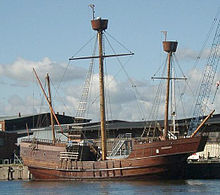
The cities of the Hanseatic League, an amalgamation of trading cities, made the first significant appearance of a German sea power. They armed their merchant ships, converted them into warships in times of war and, like Lübeck for example, became a political and military power in Northern Europe. Since the 12th century, the Hanseatic League has carried so-called red wings in the mast on its ships as a symbol of imperial power.
The naval war was mostly carried out as a pirate war, and sea blockades were also common. In view of its superiority at sea, the Hanseatic League was also able to quickly establish military focal points on land by using its ships to carry soldiers into action. The type of later marine soldier did not yet exist at that time, the crew members were seamen and soldiers at the same time, the captains also merchants. In the 16th century the power of the Hanseatic League declined.
Imperial fleets in the 15th to 17th centuries
The armed forces of the empire consisted of the troop contingents of the member states. The Reichsheeresconstitution knew military districts that had to provide certain regiments . It only regulated the formation of the land forces, there was no regulation for the naval forces. It became common practice to designate only the Habsburg-Austrian troops as imperial troops. An imperial navy only existed insofar as there were always Habsburg fleets flying the imperial flag. So from 1528 ships under the emperor's flag were equipped in Trieste , which were used in the various conflicts with the Turks and Venetians .
Fleet projects in the 15th and 16th centuries
In addition, there were some attempts to set up real imperial fleets. From 1487 onwards, there was an Imperial Admiralty in Antwerp for a few years , although its activity was limited to the local fight against piracy .
Later plans were not implemented. This included attempts to combine the ships of the Lower Saxony , Lower Rhine-Westphalian and Burgundian imperial circles in the fight against the Dutch Wassergeusen in 1571 , or the plan of the East Frisian counts to be made imperial admiral . Also Prussian-Brandenburg fleet initiatives were short-lived, and also were partly under the influence of Polish suzerainty .
Some seafarers carried the imperial flag in order to benefit from its high reputation, for example Ferdinand Magellan's ships during the circumnavigation of the world in 1519. The crews of the Trieste fleets, which existed with various interruptions until the middle of the 18th century, were mostly Italians. There was no real German naval tradition.
Wallenstein's imperial fleet
During the Thirty Years' War there was an imperial fleet in the Baltic Sea for a short time . After the Imperial Catholic occupation of Northern Germany, the Duchy of Mecklenburg Wallenstein was awarded as compensation for its financial expenses for the Emperor. With that, Wismar also fell into the hands of the imperial family. In order to be able to defeat the Danish king in this part of the Thirty Years' War known as the Low German-Danish War, the Danish islands were to be conquered. The kings of Spain and Poland and the governor of the Spanish Netherlands were also very interested in this. Therefore, in 1627, Emperor Ferdinand II. Wallenstein, together with the title “General of the Oceanic and Baltic Sea”, gave the order to build a fleet to face the Protestants in the Baltic Sea. Philipp von Mansfeld was appointed leader of this fleet . In addition to the direct opponent King Christian IV of Denmark, the trade connections of the Dutch in the Baltic Sea in particular were to be interrupted. The stock of ships consisted of requisitioned and purchased ships from Wismar and Mecklenburg, newly built small vehicles and, from 1629, also handed over Polish-Danzig ships. After Wallenstein had to give up his Danish plans in the spring of 1628, the ships under Admiral Gabriel de Roy were sent to capture in the Baltic Sea. Certainly, financial bottlenecks also played a role. After Danish and later Swedish units blocked the port of Wismar and captured one vehicle after another, the radius of action was reduced to the vicinity of Wismar. With the conquest of the city, the units were either sold, destroyed or added to the Swedish fleet. Individual ships deserted before that and ran over to the Swedish enemy, as the imperial side did not pay or paid too little. The flagship König David (Polish: Król Dawid ), a 40-gun galleon , and the galleon Meermann (Polish: Wodnik ) have been proven for this fleet .
The Consequences of the Thirty Years' War
The end of this war in 1648 meant that Germany largely lost its access to the sea. The Netherlands became independent and many ports on the North and Baltic Seas came under Danish or Swedish rule. This ended all attempts at a unified German navy for exactly 200 years. There was no German naval continuity, as found in other countries, which was mainly due to the lack of central imperial power.
Fleets of German states
Not only on land, but also on the water, the German states and cities consolidated their power by maintaining their own armed forces. They were not directed against the central state, but were necessary because of its weakness in order to defend itself.
Hanseatic cities
Some Hanseatic cities maintained their own warships long after the end of the Hanseatic League . Hamburg , whose shipping authorities still use the old Hamburg admiralty flag, did so until 1747, for example. The warships were used as part of convoy shipping to protect maritime trade against piracy. Later these fleets became more and more neglected and finally abandoned in the 18th century.
Brandenburg and Prussia
In the second half of the 17th century, Friedrich Wilhelm , the Great Elector, tried to build a navy and acquire colonies . This required a fleet that could protect trade with the colonies. The Kurbrandenburg Navy was also used in the Brandenburg Caper War against Spain, in which, however, it was only able to achieve moderate success. After some setbacks with the colonies, the navy was dissolved again at the beginning of the 18th century under the successor of the Great Elector, the later Prussian King Friedrich I. The Prussian state , which developed into a European size in the following decades, limited itself to being a continental land power over the next 150 years, with few exceptions .
Even Frederick the Great , 1744 in the possession of East Friesland and the North Sea port of Emden arrived, stuck to this policy. He wanted Prussia to participate in the flourishing maritime trade with foreign colonies without setting up its own navy. He supported the establishment of several trading companies, such as the Prussian-Asiatic Company in 1751 , whose decline began in 1756 with the beginning of the Seven Years' War . It had to be dissolved again in 1765. In 1772, at his instigation, the Societé de Commerce maritime was set up to transport trade with its own fleet, which later called itself Prussian Sea Trade and still exists today in the form of a foundation .
Austria
It was not until the second half of the 18th century that an Austrian navy was founded that no longer sailed under the imperial flag, but was a part-state navy. From 1786 the construction of this navy began, which continued with interruptions during the Napoleonic Wars until 1918.
Netherlands
On the one hand, the Netherlands belonged to the empire until 1648 and, on the other hand, it was part of the Habsburg rule, and since the division by Charles V of the Spanish-Habsburg power. Due to the weak central imperial power, their maritime forces played no role for the empire since the middle of the 16th century. However, the Flemish Admiralty should support the Wallenstein fleet creation and send ships, crews and experts. This did not happen due to our own want and need. The Austrian Netherlands , today's Belgium , belonged to the empire and the imperial power until 1795. Their merchant ships therefore sailed under the imperial flag. The Austrian Netherlands did not own warships.
Elbe customs frigate
The Elbe customs frigate, which was stationed near Stade from the middle of the 17th to the middle of the 19th century, was a specialty. With the beginning of Swedish rule over the Duchy of Bremen in 1648, the customs station at Stade, which had existed for centuries, was assigned a frigate as a guard ship. Even after the Duchy of Bremen became part of the Electorate of Braunschweig-Lüneburg in 1715 , the customs post was maintained with a frigate or smaller vehicles. After the Napoleonic wars, the Kingdom of Hanover maintained an armed brig until 1850 . Even if the ships were considered warships and were used as such in times of war to a lesser extent, they did not represent a sea power of their own. Nothing is known of the participation of the last ship, The Piercer, in the battle against Denmark in 1848/49.
All-German fleets 1815-1945
German Confederation
After the Napoleonic Wars, the German Confederation was established in 1815 as the successor to the old empire. The German Confederation also organized its defense by relying on contributions from its member states. The German Confederation benefited from the fact that three of the federal princes in personal union were kings of countries with their own fleets. The Kingdom of Hanover was in personal union with Great Britain , which commanded the most powerful fleet in the world. The Grand Duchy of Luxembourg was in personal union with the Kingdom of the United Netherlands and the King of Denmark was also Duke of Holstein . However, the federal act did not provide for a uniform navy.
In the Mediterranean had Austria-Hungary own navy . Prussia only had a rudimentary naval force and the Prussian maritime trade as a state shipping company under the Prussian war flag.
The fact that the precautionary measures based on external contributions were insufficient to secure Germany's maritime interests became increasingly noticeable in the first half of the 19th century. Around 1840, North African corsairs penetrated into the North Sea and brought up German merchant ships . They could only be driven out with the help of Great Britain and against payment. After the personal union between Great Britain and Hanover ended in 1837, British interests in protecting the German North Sea coast also disappeared and Denmark remained the only possible maritime protective power. The idea derived from this in Germany of making it the so-called admiral state of the German Confederation was vehemently rejected there because it was seen as an attempt to incorporate the entire Danish state into the German Confederation.
Imperial Fleet 1848–1852

Than during the German Revolution of 1848/1849 to war with Denmark came, was from the supposed protector of Denmark a war opponents. At that time Austria was too preoccupied with its own unrest, and Prussia had to interrupt its support for the Schleswig-Holstein insurgents several times and finally stop: the other great powers, especially England and Russia, had threatened war because they ruled Denmark over the Wanted to get access to the Baltic Sea.
It turned out that the German coastal states and their merchant fleets were without protection. In a very short time Denmark had blocked German ports and seized ships. As a consequence, practical steps began to build up an all-German fleet in the course of the attempted unification of the empire. The Frankfurt National Assembly , which met on May 18, 1848, decided on June 14, in one of its first significant decisions, to set up a German fleet and provide six million Reichsthaler for it . Prince Adalbert of Prussia , who was generally regarded as a naval expert, was head of the Technical Marine Commission . In fact, on June 4, 1849, there was a naval battle between the imperial fleet under Admiral Brommy and the Danes. After the suppression of the revolution, the imperial fleet became the property of the restored German Confederation. Since no state wanted to take over the imperial fleet, it was dissolved. Their last ships were auctioned off in 1853.
Partially independent of the Empire fleet operated as Schleswig-Holstein flotilla called Schleswig-Holstein Marine insurgents in Schleswig-Holstein in the Baltic Sea and to the fighting setting by the Imperial fleet in the North Sea.
Prussian Navy
The lessons of the war against Denmark led to the expansion of the navy in Prussia under the direction of Prince Adalbert. The Prussian Navy was not an all-German one, but it was the predecessor of all later German fleets. In 1853 Prussia acquired from the Grand Duchy of Oldenburg with the Jade Treaty an area on the west bank of the Inner Jade and on the northwest bank of the Jadebusen , on which the city and the base of Wilhelmshaven arose in the following years .
Although this navy was not yet able to face the Danish navy on its own in the German-Danish War of 1864, it was possible to assert itself with the help of a squadron of the Austrian navy under liner captain Wilhelm von Tegetthoff (see naval battle off Helgoland ). In the German War of 1866, too, the navy only played a subordinate role; in the war between Austria and Italy there were naval operations.
Plan for a federal fleet in 1865
Prussia and Austria signed the Gastein Convention in August 1865 . It concerned the administration of Schleswig and Holstein. At the time, these countries were part of an Austro-Prussian condominium . The two major German powers agreed to apply to the German Confederation to set up a federal fleet. Kiel was to become a federal port for this fleet under initially Prussian administration. Because of the German War that broke out in June 1866 , this plan was not implemented.
North German and Imperial Navy 1867–1918

In 1867 the Prussian Navy became the Navy of the North German Confederation . As with the land forces, the Prussian king (Art. 53 of the Federal Constitution ) had the supreme command . He exercised the functions of Federal Presidium and Federal General in the North German Confederation . In the Franco-German naval war of 1870/1871 there were a few encounters with French ships. During the war, the southern German states joined the North German Confederation, which was renamed the " German Empire" . In accordance with the new title of “ German Kaiser ” for the Prussian king, the navy became the Imperial Navy.
At first it was built up slowly. In the 1880s she was involved in winning some colonies in Africa , Asia and Oceania and represented the empire in many parts of the world without wanting or being able to compete with the navies of the other great powers. Only under Kaiser Wilhelm II and the State Secretary in the Reichsmarineamt Alfred von Tirpitz did the rapid build-up of a large fleet begin. In the 1890s the plans for the construction of the deep-sea fleet emerged , which should put Germany in a row with the great sea powers , behind England and the USA.
The fleet armament went hand in hand with a large number of technical innovations. Towards the end of the 19th century, the new type of ship, the torpedo boat , emerged, and at the beginning of the 20th century this was followed by large torpedo boats , submarines, naval airships and naval aviators, as well as large-line ships of the size of the British dreadnought class.
Despite the intensive and modern armament, it was not possible to force a war decision against Great Britain with the deep sea fleet due to a lack of strategy. Although the Royal Navy could suffer significant losses in the Battle of the Skagerrak , the turning point in the war did not materialize. The unrestricted submarine war declared in 1917 brought successes against Great Britain, but it was also the pretext under which the United States entered the war against Germany in 1917.
A poor supply situation and the order to leave for a final battle led to a sailors' uprising in the high seas in autumn 1918 , which culminated in the November Revolution and thus the end of the monarchy and the First World War. After the end of the war, the deep-sea fleet scuttled on June 21, 1919 in Scapa Flow, Scotland .
Imperial Navy after the First World War
According to the Versailles Treaty , Germany was only allowed to maintain a small navy. The strength of this Reichsmarine was limited to 15,000 men and there were strict requirements regarding size, number and renewal of the ships. Planes and submarines were not allowed. Reich President Friedrich Ebert initially wanted to forego the reconstruction of a navy altogether. In view of the already weak armed forces granted to Germany by the Versailles Treaty, however, it did not seem justifiable to voluntarily forego some of these forces. In addition, there was pressure from the victorious powers to clear sea mines from the Baltic and North Seas.
On the basis of a law approved by the Weimar National Assembly on April 16, 1919, the Provisional Imperial Navy was initially created . Their tasks were mine clearance, coastal protection, fisheries protection, maritime police and support for merchant shipping .
The short period of the Provisional Reichsmarine was determined by a number of important events and developments in German history in which it was directly or indirectly involved:
- the revolutionary confusion of 1918-1919 ;
- the delivery and subsequent self-sinking of the deep sea fleet ;
- the signing of the Versailles Treaty;
- the Kapp putsch .

The behavior of the naval leadership during the Kapp Putsch and secret armaments projects repeatedly brought the Reichsmarine into negative headlines. Between 1922 and 1935, the naval command tried to modernize its fleet and to relax the Versailles restrictions. It relied on political changes and technical innovations.
On July 26, 1932, Reichswehr Minister von Schleicher announced that Germany was no longer bound by the restrictions of the Versailles Treaty, and approved a reconstruction plan for the navy that would expand its size, expand its armament beyond what was previously permitted, and in particular create a U -Boat gun and a naval air force including an aircraft carrier . Thus, before the end of the Weimar Republic, the prerequisites were created for the Reichsmarine to build up adequate combat strength for the defense tasks of the Reich.
Navy
After the Nazi regime came to power in 1933, Germany's rearmament soon began . The fleet agreement with Great Britain of June 18, 1935 allowed the construction of a fleet of 35 percent of the British surface tonnage. The navy, renamed the Kriegsmarine shortly after the naval agreement , was to receive a large number of new ships by 1947 according to the Z-Plan , including battleships , aircraft carriers and many submarines.
During the Spanish Civil War , the Navy in the Mediterranean, together with naval forces from Great Britain, Italy and France, took part in the international naval blockade to implement an arms embargo against Spain . It supplied the putschists with weapons and shelled Almería on May 31, 1937.

At the start of the war in 1939, too little of the armament plans had been implemented for the Navy to be prepared for the Second World War . Nevertheless, she was involved from the first minute. It was the old Schleswig-Holstein liner, used as a cadet training ship , which opened fire on the Westerplatte on September 1, 1939 at 4.45 a.m. in Danzig .
Due to the inferiority of the larger combat ships, made clear by early losses ( Admiral Graf Spee 1939, Blücher 1940, Bismarck 1941), the Navy shifted more and more to submarine warfare , largely pushed by its commander, Admiral Karl Donitz . After a few debacles in the fleet in the North Sea, Hitler even wanted to scrap the large units. Erich Raeder asked for his resignation at the end of 1943 and Admiral Dönitz became Commander in Chief of the Navy. Only on his initiative could the remaining capital ships be preserved. From now on, large ships like the Tirpitz , sister ship of the Bismarck , were moored in occupied Norway as a “ fleet in being ”. In addition, coastal warfare with small vehicles such as minesweepers and speedboats made up a large part of German naval activities in World War II.
Despite initial successes that brought Great Britain into a supply crisis at times, it was not possible to bring the enemy to their knees with submarines. As in World War I, the Allies ruled the sea and cut off Germany from overseas supplies. The associated lack of resources to wage the war was one of the reasons the war was not to be won.
In the last weeks of the war, and in some cases beyond the end of the war, the navy played a key role in the repatriation of German troops and civilian refugees across the Baltic Sea. Together with the merchant navy and with considerable losses (e.g. sinking the " Wilhelm Gustloff "), it was possible to save over two million people from the Red Army , the largest evacuation in human history.
German navies after 1945
German maritime associations 1945–1955
After the unconditional surrender of the German Wehrmacht , the Navy was also disbanded by the Allies. However, some of the staff remained on duty to clear sea mines on the German coasts. This German mine clearance service (English: German Minesweeping Administration / GMSA) had at times over 27,000 men and 300 vehicles under the supervision of the western allies. It was transferred to a smaller organization in 1947. In the years to come, German maritime associations, such as the Maritime Customs , Maritime Border Protection and so-called Allied Service Groups , cleared mines off the German coast so that German seaports could be called safely again. The so-called Schnellbootgruppe Klose carried out various special operations in the Baltic Sea on behalf of the British.
In the Soviet occupation zone , too, there were sea units of the German border police as early as 1946 , from which the barracked people's police (sea) emerged in 1950 .
Federal Navy
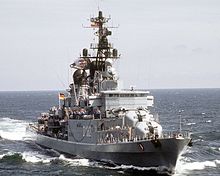
With the establishment of the Bundeswehr, armed forces emerged in the Federal Republic of Germany that did not follow the tradition of the former German armed forces. Rather, they were designed as a completely new military organization, which, however, had to fall back on former soldiers of the Navy. Younger seafarers trained in the maritime associations, however, were rarely taken on. For the Federal Navy set up in 1956 as a part of the armed forces, the maritime units nevertheless formed a basis. They made it possible for her to assign two operational mine sweeping squadrons to NATO as early as April 1, 1957, as the first German contribution to the alliance.
Unlike all of its predecessors, the German Navy was conceived as part of an existing military alliance. It had a clear mandate to defend the territory of the NATO countries in the area of the Baltic Sea accesses and to protect Allied reinforcement transports in the North Sea and North Atlantic . Use outside of these areas was not initially planned. Nonetheless, she represented the Federal Republic of Germany on trips abroad. The strength of the German Navy was about 38,000 men with over 200 ships and boats; in addition there were up to 190 aircraft.
After reunification in 1990, the navy was downsized and reclassified with the inclusion of parts of the People's Navy. Since 1995 the German Navy has been the official name for the German naval forces.
Barracked People's Police (lake) and People's Navy
In establishing the National People's Army (NVA) in January 1956, she was the Kasernierten People's Police (Lake) 10,000 man with almost 100 vehicles in its Marine assume that since November 3, 1960, the anniversary of the Kiel mutiny of 1918, People's Navy said. It had about 17,000 men (1973) and a large number of smaller vehicles such as minesweepers, speedboats and smaller landing ships , but no submarines. Like the NVA, the Volksmarine was dissolved on October 2, 1990. Some of their personnel and some ships were taken over into the German Navy.
German Navy after 1990
Even after 1990, the Navy changed rapidly, and in particular the organization that was captured after 1990 has been obsolete since 2006. The fleet was structured as follows from around 1993 to 2006:
Tradition and customs of the navy in the present
tradition
The traditional relationship has changed considerably over time. Nowadays, the navy maintains German military traditions as laid down in the guidelines for understanding and maintaining tradition in the Bundeswehr, which are binding for the entire Bundeswehr .
Of great importance for the navy is the historical reference to the Reichsflotte of 1848, the joint fleet under the black, red and gold flag set up by the first freely elected all-German parliament . As a reminder of the resolution of 14 June 1848, the Navy celebrates this date every year as the Navy birthday.
regional customs
The maintenance of military customs goes hand in hand with the maintenance of tradition . The customs in the navy originate on the one hand from their own tradition, on the other hand they are based on the international custom of many navies and seafarers. The naval ceremonial is similar in many navies, the sailor's language is also used on merchant ships with a few differences . The uniforms of the navies are also an expression of the cultivation of customs.
Typical forms of ceremonial are the “ front ” and “ side ” badges of honor , which senior officers and personalities attest when entering and leaving a ship.
Sponsorships and ship names
All ships in the navy are sponsored by a state or a city . Some of these relationships are very old, especially when there have been several ships with the same name in history. There were ships with the names Bremen , Hamburg and Lübeck as early as 1848 in the imperial fleet . The future Corvette Emden of class 130 will be the sixth bearer of this name.
For some years now, the Navy has only been giving ship names with a geographical reference in order to facilitate sponsorship. In addition, discussions about personalities should be avoided.
See also
- List of names of warships in the HRR
- List of ships in the Reichsflotte
- List of names of German warships (A – M)
- List of names of German warships (N – Z)
Crewen
Marine museums, memorials and memorials
A number of museums and other memorials in Germany commemorate German naval history. The best known are:
Defense history training center of the Mürwik Naval School
The military history teaching collection of the Naval School Mürwik , the officers' school of the Navy, provides information on 150 years of German naval history.
Naval Memorial Laboe
The Naval Memorial in Laboe near Kiel is the Navy's central memorial in memory of their dead. It was built between 1929 and 1936 as a memorial for the fallen members of the navy in the First World War and is now owned by the German Navy Federation . Ships of the German Navy that pass the memorial when entering or leaving Kiel pay military honors.
The U-995 submarine from the Second World War is on display at the foot of the memorial on the beach . As a type VII C boat, it is a typical representative of submarine warfare, as shown in the film " Das Boot ".
Möltenort submarine memorial
The Möltenort submarine memorial is located on the east bank of Kiel and serves as a memory of the fallen submarine drivers of both world wars. Like the Naval Memorial Laboe, it was created between the world wars.
German Naval Museum Wilhelmshaven
The museum deals with German naval history since 1848 with a focus on the German navy . Several warships of the German and People's Navy are shown, including the former mine-hunting boat "Weilheim", plus a changing exhibition with extensive explanations. The largest exhibit is the former destroyer " Mölders ".
Aeronauticum Nordholz
The Aeronauticum in Nordholz in Cuxhaven is a German airship - and the Naval Air Museum, the history of the German naval aviator and especially the Navy blimps that here in the First World War had their largest base.
Marinemuseum Dänholm
The Danish Navy Museum is located on the site of an old naval training unit on the Stralsund island of Dänholm , which was used both before the Second World War and by the People's Navy. The focus of the exhibition is the naval history of the Stralsund garrison .
See also
Individual evidence
- ^ John B. Hattendorf : Germany and the sea: Historical roots of German naval forces until 1815. In: Werner Rahn (Hrsg.): German Marines in Transition. From a symbol of national unity to an instrument of international security. ISBN 3-486-57674-7 , p. 17 ff.
- ^ Köhlers Flottenkalender , 1968, 56th vol., Wilhelm Köhler Verlag. Minden / Westf.
- ↑ Elmer B. Potter, Chester W. Nimitz, Jürgen Rohwer : Seemacht . Munich 1974, p. 16.
- ^ A b Franz Hermann Huberti: German naval policy at the turn of the Middle Ages to modern times . Review of Karl R. H. Frick: Forgotten fleets - fleets and fleet construction plans in the Holy Roman Empire of the German Nation from the 15th century to 1632. In: Marineforum . No. 4, 1991, p. 121.
- ↑ Elmer B. Potter, Chester W. Nimitz, Jürgen Rohwer : Seemacht . Munich 1974, p. 28.
- ↑ Dieter Flohr: The forgotten fleet - Wallenstein's ships in Wismar (1628-1632). In: Marineforum. No. 7/8, 1999, p. 35f.
- ^ Gerhard Wiechmann: The Prussian-German Navy in Latin America 1866-1914: a study of German gunboat policy. (No longer available online.) In: Oldenburg 2000 (dissertation). Archived from the original on June 9, 2008 ; accessed on April 8, 2019 .
- ↑ Claudia Beindorf: "Forever undivided" - A place of remembrance between Denmark and Germany .
- ↑ Hartmut Klüver (Ed.): German Sea Associations 1945–1956 . ISBN 3-935091-08-7 .
- ↑ Jörg Duppler: Continuity and discontinuity in the navy's self-image. In: Marineforum. No. 4, 1996, p. 2ff.
- ↑ mandors.de ( memento of September 6, 2010 in the Internet Archive ), accessed on April 8, 2019
- ^ Homepage of the German Navy .
- ↑ Traditional decree for the Bundeswehr .
- ^ Marine.de Official website of the Navy, accessed on February 10, 2018
literature
- Albert Röhr: German naval chronicle . Oldenburg 1974.
- Fritz E. Giese: Small history of the German fleet . Bechtermünz, Augsburg 1998, ISBN 3-8289-5321-2 (reprint of the 1965 edition).
- Werner Rahn (Ed.): German Marines in Transition. From a symbol of national unity to an instrument of international security. Oldenbourg, Munich 2005, ISBN 3-486-57674-7 .
- Konrad Ehrensberger: 100 Years of Organization of the German Navy 1890–1990. Bernard and Graefe, Bonn 1993, ISBN 3-7637-5913-1 .
- Karl RH Frick : Forgotten Fleets. Fleets and fleet construction plans in the Holy Roman Empire of the German Nation from the 15th century to 1632. Weishaupt, Graz 1990, ISBN 3-900310-73-4 .
- Günther Meyer: The Wallenstein fleet in the Baltic Sea 1627 to 1632. In: Ship and time / panorama maritim. 36, 1992, pp. 38-45 and 37, 1993, pp. 6-12.
- Elmer B. Potter, Chester W. Nimitz, Jürgen Rohwer : Seemacht . Munich 1974, ISBN 3-7637-5112-2 .
- Rolf Noeske, Claus P. Stefanski: The German Marines 1818-1918. Organization, uniforms, armament and equipment . 2 volumes. Verlag Militaria, Vienna 2011, ISBN 978-3-902526-45-8 .
- Heinrich Schmidt: The Cirksena and the plan of a German imperial fleet under Edzard II and Enno III. In: Ostfriesland. Magazine for culture, economy and transport. No. 2, 1963, pp. 1-9.
- Jakob Kinau : The struggle for sea supremacy from the Hanseatic League to the World War . JF Lehmans Verlag, Munich / Berlin 1938.
- Guntram Schulze-Wegener : Germany at sea. Illustrated naval history from the beginning to the present day . 2nd Edition. Publishing house Mittler & Sohn, Hamburg / Berlin / Bonn 2011, ISBN 978-3-8132-0920-4 .
- Heiko Herold: Imperial violence means sea violence. The cruiser squadron of the Imperial Navy as an instrument of German colonial and world politics 1885 to 1901 (Contributions to Military History, Vol. 74, also Phil. Diss. Heinrich Heine University Düsseldorf). Oldenbourg Verlag, Munich 2012, ISBN 978-3-486-71297-1 .







